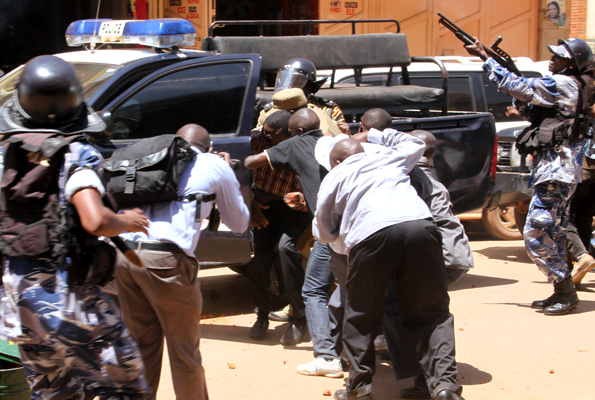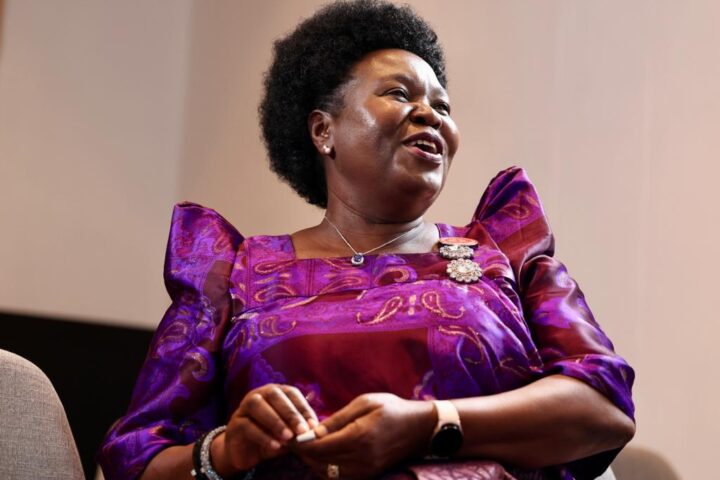To many Kampala residents, downtown protests that involve running battles between the Uganda police, para-military forces and “opposition” crowds may as well be taking place in another universe.
Save for the fear of spillover, the drift of teargas and traffic hold-ups, these harambes are becoming very much a class issue. In the sense that they represent several schisms in Ugandan society or simply show how schismatic the society is, compartmentalized and unable to act “collectively”. In the city or Kibuga there is the office worker who takes the conspicuous orange Pioneer buses and the matatus to the city to their jobs. Seated or standing crammed like the cows from western Uganda brought in trucks to the city’s abattoirs he or she routinely shares the narrow roads with the “my car” class who drive themselves to work. Then there is the rest.
It is difficult to say how much bigger the rest are.
Let us call the two classes, the motorized and the non-motorized groups. Perhaps we could also call them in Orwellian fashion the class of the “four wheels” and the one of the “two wheels”. This may fit better since a great majority of the city is chauffeured on motorbike taxis known as “boda bodas”.
Walk to work also offers powerful symbolism. Walking suggests mobility, forward movement even. Walking to work implies self help and progress. What is as clear as a matooke forest is that even if the protest movement of early 2011 is led by four-wheeler politicians opposed to the ruling NRM government they were subscribed to by random armies of two-wheeler classes. After all if two wheels are good, four wheels are better right?
In the wake of the Arab Spring, which this year is being revised into the Arab Fall (after post-revolutionary shocks like Libya and Egypt), the police reaction to protests of this variety has thus been one of regime security. The bashing of skulls, arrests and now allegations of a “rebel movement” in Uganda have been a generic reaction to political protests that tap into the disgruntled classes at the bottom of society.
Judging by the videos of brutal arrest of the main Opposition leader Dr. Kizza Besigye uniformed officers clashed with bands of the “two-wheelers” who also wore uniforms. The checkered blue of the para-military riot police color clashed with the blue overalls of the mechanics and porters of Kiseka market.
Kampala which produces 70-80% of Uganda’s GDP has become simultaneously a battle ground not just for leadership of the country but also of the economy with all its contradictions. As the protests rocked downtown,which is also home to Uganda’s trading district, the Minister of Finance Maria Kiwanuka (who before her elevation to high office run a radio station in the protest heartland) was presiding over a ceremony up town announcing a slight increase in the benefits of members of the Uganda’s only “social security” scheme. The fund has less than half a million members and with it represents Uganda’s formal workers.
To be fair this does not represent the entire formal sector but is the only real existing measure of “state capture” of the working classes. The fund itself is worth slightly over a billion dollars but owes its success to the absence of competition not to a stellar performance. To put it differently what would the fund look like with just 5 million members out of Uganda’s 34 million population?
To get the political dilemma for the sitting government understand that the country’s exports trail imports by almost double. In the 2011/2012 period the agency responsible for exports reported that they stood at $2M while imports surged at $5M]. Excise taxes are the principal source of revenue of the government. Thus disruptions in the downtown district generally punch higher in their implications. The rest of official income is through donors and other opportunistic taxes focused mainly on the narrow working classes in the formal sector represented by NSSF members. A crisis in Kampala for two weeks may well mean a government has had its day.
But the problem referred to above are also a tension not just between the two-wheelers and their better off four-wheelers but of what I call the real Ugandan governance crisis- that of major information asymmetries.
The huge informal economy has seen from the size of the formal sector reveals the following problems. First that government has we know it requires the use of brute force to exercise control because most inhabitants of the land are in effect undocumented citizens. There is no national Identity Card and has no effective way of tracking the activities of individuals either for political or economic reasons (well in Walk to Work the two are linked). This is also a statement of the penetration of the state as an organizer of society and wealth. In more “advanced” countries documented citizens are born into a system that can track one’s growth and contributions to society. But the information society is also the technology of wealth creation best captured by Hernado De Soto in his book “The Mystery of Capital”.
The absence of the informed state explains away state capacity as well as the state of competition for power. Put differently why one can have the “occupy movement” elsewhere and the ” Arab Spring” and its antecedents over here. During the last three major riots, the Mabira Forest protest [April 2007], the Buganda riots of [September 2009] and Walk to Work [April 2011], there was no proper account of its victims.
The government and its opponents reported different figures.
It is not just an account of the violence here but that violence or the threat and fear of it remains the principal means to impose control over the country. Unsurprisingly political competition itself has been violent with Walk to Work being perhaps the least violent episode in Uganda’s recent history. Competitors for power like Besigye find themselves flirting with an investment in violence or a violent proposition capable of competing with that of the government in power.
In contrast several other societies were the size of the information society has advanced offer more opportunities for non-violent or less violent competition. Perhaps this is because the size of the so-called formal sector is significant and organized in such a way that the interests that coalesce around issues like a bad economy in radically different ways. Information and by this we mean not only the freedom of speech, access to information and the like but also the organization of knowledge has always been key to democracy. The extent of an information society is a measure of state capacity and its absence the degrees of state “failure”. So with such massive asymmetries opposition politicians like Besigye find themselves with few avenues to organize “civilly”. The form of opposition his street protest immediately disenfranchises his tea drinking and cocktail bound supporters uptown. They can only join when the violence triggers a crisis which disrupts their routine and prospects in a more permanent fashion.
But worse for a sitting government is that violent competition is itself unsustainable. For the NRM it is also counterintuitive at many levels. Since security of person and property has been the its principal political sell, the violence against opposition figures may not cause the disruption we have seen elsewhere but it is certainly de-legitimizing over the long run.
Over to you.










